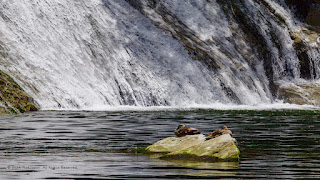Download a licensed digital photo: pix4japan.picfair.com
Order a print: pix4japan.smugmug.com
The Nostalgic Charm of Kazusa-Nakano Station
Location: Otaki Town, Chiba Prefecture, Japan
Timestamp: 13:50・2024/07/10
Fujifilm X100V with 5% diffusion filter
ISO 640 for 1/250 sec. at ƒ/2
Provia/Standard film simulation
On my journey home from Katsuura along Chiba’s Pacific coastline, I headed inland and stumbled upon a hidden gem—Kazusa-Nakano Station. This quaint little train station instantly transported me back in time with its unmistakable Showa-era charm, a relic of a simpler, quieter Japan when I was much younger. Serving both the Isumi Line and Kominato Line, this station feels like a nostalgic postcard from the past.
Kazusa-Nakano Station, with its single platform, seems almost suspended in time. One side of the platform is for the Isumi Line, while the other side welcomes the Kominato Line. The station remains unstaffed, enhancing its tranquil and somewhat remote atmosphere. Here, there are no bustling ticket gates, loud announcements—just the hum of a diesel train waiting for departure. Be sure to carry exact change for your fare, or plan ahead and purchase tickets at the terminus, Ohara Station.
Originally constructed in 1928 and rebuilt in 1989, the station has retained its old-world charm. The analog clock above the entrance is a delightful reminder of days gone by, ticking away in harmony with the slow pace of life here. The hand-carved station sign is weathered by time with parts of the lettering preserved by the warmth of nearby lamps.
Inside, where my border collie found a peaceful spot to rest, the station offers a few simple amenities—a collection of pamphlets for curious tourists, a timetable for planning unhurried journeys, and a large notebook brimming with anonymous messages. These notes capture the thoughts and feelings of visitors, whether they’re reflecting on the quiet beauty of the station, the gentle ride along the Isumi Line, or their adventures in the local area.
In the background, a single-car train of the Isumi Line waits patiently for its next departure. The schedule is leisurely, with trains arriving about once an hour. There are even moments when the station falls silent for up to 90 minutes, allowing you to pause and savor the tranquility of your surroundings.
References:
Copyright Notice for All Images:
© 2011-2024 Pix4Japan. All rights reserved.
Unauthorized use for AI training is strictly prohibited.
Visit www.pix4japan.com for prints and licensed download options.







